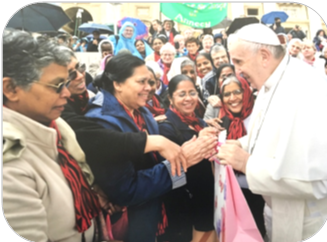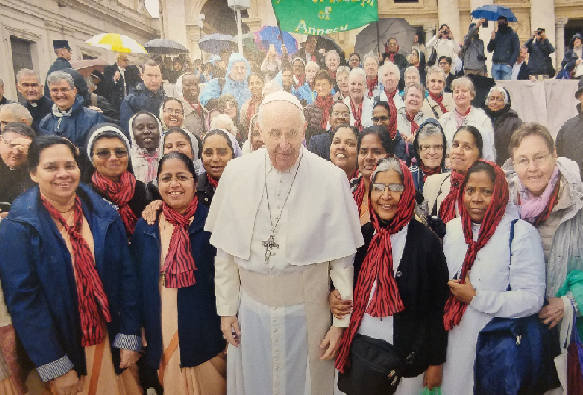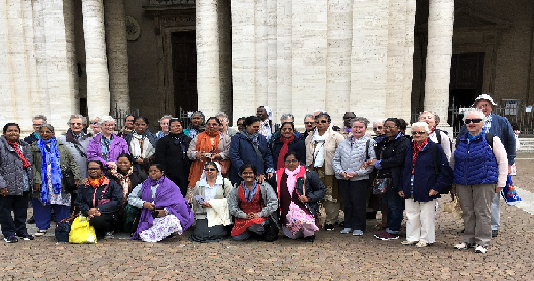POLITIQUE DE SAUVEGARDE DES ENFANTS ET DES ADULTES VULNERABLES POUR LA CONGRÉGATION
« Conscientes que tout est lié, et que nous vivons en interdépendance, nous, Sœurs de Saint Joseph d’Annecy, sommes invitées à prendre davantage conscience de notre responsabilité face au Charisme confié et à le transmettre de façon créative. » Orientations Chapitre Général 2019
Nous, Sœurs de Saint-Joseph d'Annecy, sommes engagées pour la sécurité et le bien-être des enfants et des adultes vulnérables dans toutes les circonstances et situations.
Nous croyons que la vie humaine est sacrée dès la conception jusqu'à sa fin naturelle, et que c'est Dieu qui appelle chaque personne à entrer dans une relation spéciale avec Dieu . En conséquence, nous reconnaissons que chaque être humain, indépendamment de son âge ou des circonstances, doit se voir accorder la dignité et le respect dus à un enfant de Dieu et nous reconnaissons le caractère unique de chaque vie humaine. Cette croyance et ce principe fondamental sont repris par notre fondateur, le P. Jean Pierre Médaille, dans nos documents de Congrégation :
« Comblées à chaque instant de la plénitude de l’Amour trinitaire, nous consacrons notre vie à transmettre ce don reçu à tous ceux vers qui la Congrégation nous envoie. » (Const. #38)
« Sœurs de Saint-Joseph d’Annecy, fidèles à l’idéal que notre Fondateur, le Père Médaille, nous a proposé, nous voulons « avancer la plus grande gloire de Dieu par l’exercice de l’amour de Dieu et du prochain ».(TP)
Les Sœurs de Saint-Joseph d'Annecy sont présentes dans10 pays à travers le monde - France, Suisse, Inde, Irlande, Pays de Galles, Sénégal, Gambie, Congo, Tanzanie et Kenya. Chaque Entité a sa propre politique de sauvegarde et les Sœurs suivent les directives civiles, juridiques et ecclésiales établies dans les pays où elles vivent.
La Congrégation s'engage à protéger tous les enfants et adultes vulnérables dont nous avons la charge et tous ceux avec qui nous sommes en contact. Nous acceptons que, par définition, un enfant est une personne âgée de moins de 18 ans et qu'un adulte vulnérable est une personne qui " en raison d'une altération ou d'une insuffisance de ses facultés personnelles, n'est/ne sont pas en mesure de protéger ses/leurs intérêts ". (Convention de La Haye de 2000 sur la protection des adultes).
Nous affirmons que toute forme d'abus est intolérable et non conforme à notre vision et à nos principes fondés sur les valeurs évangéliques, notre charisme, les textes de la Congrégation et les enseignements de l'Église à cet égard.
Nous reconnaissons que les abus peuvent prendre de nombreuses formes, principalement :
- Violence physique
- Abus sexuel
- Abus spirituel
- Violence psychologique/affective
- Exploitation financière
- Négligence
- Les abus subis via l'internet et les plateformes de médias sociaux
- Discrimination
Indépendamment des traditions culturelles nationales ou locales du lieu où nous vivons et exerçons notre ministère, en tant que Sœurs de Saint Joseph d'Annecy, nous ferons tout ce qui est en notre pouvoir pour que tous les enfants et adultes vulnérables soient protégés de tout ce qui pourrait leur nuire ou nier leur dignité innée.
Au niveau du Généralat, nous veillerons à ce que :
- une sœur désignée responsable de la sauvegarde est nommée dans chaque entité de la Congrégation et elle reçoit une formation et un soutien adéquate pour remplir cette fonction.
- chaque Entité de la Congrégation dispose d'une Politique de Protection des Enfants et des Adultes Vulnérables solide, qui inclut le processus pour l'enregistrement et les rapportsde signalement de tout incident de maltraitance/abus.
- Politiques de l'entité doivent être révisées et mises à jour régulièrement.
- chaque sœur est pleinement au courant de la Politique de Protection des Enfants et des Adultes Vulnérables de son entité et connaît le processus de signalement d'un incident de violence.
- chaque année, en janvier, chaque Entité soumet au Généralat une copie de son document d'enregistrement et de déclaration de l'année précédente, même s'il s'agit d'une déclaration nulle. Ces documents doivent être conservés dans les archives de la Généralate.
- toutes les sœurs reconnaissent qu'il existe une distinction entre un adulte vulnérable et un adulte qui, à certains moments, peut se trouver dans une "situation vulnérable". À cet égard, toutes les femmes en formation sont traitées de la même manière que les adultes vulnérables, conformément aux valeurs et aux principes de sauvegarde de la Congrégation.
- toute personne signalant un problème de protection ou un incident d'abus (appelée dans certaines cultures "dénonciateur") est traitée avec respect et dans une atmosphère de confidentialité.
- avant qu'un ministère collaboratif ne débute, la Supérieure Majeure de cette Entité s'assurera que l'autre Congrégation ou organisation a mis en place une politique de Sauvegarde. C'est un critère pour participer à un ministère collaboratif.
- Les procédures de sauvegarde sont révisées lors de la visite officielle des communautés.
Tous les membres de la Congrégation sont tenus de vivre conformément à ce document.
La politique de sauvegarde de la Congrégation a été adoptée par la Supérieure Générale et son Conseil le 15 mars 2024. Elle sera revue au plus tard le 14 mars 2027.
Supérieure générale : Sr. Marie Pierre Nadiaye.
Assistante générale : Sr. Tessy Thekkedath.
Conseillère générale : Sr. Lizzie Thomas.
Conseillère générale : Sr. Deepa Koturu.
Conseillère générale : Sr. Jackie Bianquinch.
Meeting of Neighbours
at Thônes community, 18 September 2021
After the long period of confinement and "sanitary barriers", we suggested, as a community, to meet our neighbours in the courtyard in front of our house.
This desire was mainly to get to know each other in a joyful way around a Canadian meal. We distributed a beautiful invitation in all the mailboxes, made with the help of Christian, a computer expert.
In the sense of sharing and the tradition of the Canadian picnic, we asked that everyone bring something: salads, cheese, food both salty and sweet, drinks etc. Sister Monique coordinated the choices.
The day arrived. Christian and Claudette set up the tables and benches in the courtyard, while others prepared the layout for the aperitif. Then it’s time to share! 25 people arrived with food or drinks for the sharing. The sisters came out to greet the arrivals. There were 35 of us in all. Several people had said they were sorry they could not be there.
During the aperitif, we were already getting to know each other, moving towards each other in joy and under a bright sun!
At coffee time, a couple made all of us sing along with Fr. Dominique in a joyful atmosphere.
Then, as all good things must come to an end, we had to finish this beautiful meeting. Before leaving, several people took part voluntarily in the tidying up in joy.
All said before leaving: Thank you and See you again!
Sisters Monique and Raymonde

Feast of the Immaculate Conception : 8th December 2020
My Dear Sisters,
Special greetings to each of you from myself and the General Team on this the feast of the Immaculate Conception. May each of you be truly blessed by the Blessed Virgin on this her feast day. As Sisters of St. Joseph we are invited by our founder to commemorate this feast when the mother of Jesus was graced by God to lead a life of holiness, free from sin. Fr. Medaille suggested that we would set aside three days of recollection in order to pray to Mary to obtain from her Son Jesus, our deepest desires for holiness an ardent zeal for the salvation of the neighbour and a great purity of intention in all our conduct.” (Spiritual Directory).
The Feast of the Immaculate Conception centres on the belief that Jesus's mother, the Virgin Mary, was conceived without sin. Pope Pius IX issued an apostolic constitution, known as the Ineffabilis Deus, on December 8, 1854. This document clarified the importance of the Immaculate Conception in the Catholic Church.
On the feast of the Immaculate Conception last year, Pope Francis prayed that this feast might help us to make our whole life a “Yes” to God and a “yes” made to adoration of Him and of daily gestures of love and service. Little did we know then how the year would unfold and how we would be challenged to use our love and service whilst thinking and reflecting on this in the wider context.
How has our “yes” been tested during this world pandemic? The global coronavirus pandemic, which has brought death to hundreds of thousands, serious illness to millions more, and financial hardship to the whole world, also poses profound spiritual questions and real challenges to us as Sisters of S. Joseph and indeed to all Christians. In the last few months here in Annecy the virus – Covid 19 -came to our Home in Vieugy. It claimed the lives of at least 15 residents and several sisters and priests. It was a fundamental test of our faith in God and in God’s Providence, and we find ourselves invited to re-examine our relationship with God and with the planet on which we live. These sisters who died are among the many who have gone before us and on whose shoulders we stand. You are familiar with the song:
“Standing on the Shoulders of the Ones who came before us”
We are standing on the shoulders of the ones who came before us,
We are stronger for their courage; we are wiser for their words....
We imagine a world (a Congregation) if they hadn’t tried...
We wouldn’t be gathered here today. …………..”
These Sisters said their “yes” not knowing how it would unfold. Mary said her “yes” as a young Jewish woman within her context. Our sisters who died here also said their “yes” to Gods plan. What is our context in the 21st Century?
Each one of us is unique and created and called for a purpose. Each one of us is called to Mission. John Henry Newman wrote that everyone who breathes has a mission and a purpose on this planet. What is yours?
We are living through turbulent times and in his most recent Encyclical, Fratelli Tutti, Pope Francis challenges us to love outside the box. That we become one human family with rights which are respected……He wants our love to cross boundaries and to reach out to those of other faiths and beliefs, putting an end to war and violence of every kind… This was so clearly seen in the Elections in USA where the president elect used the same sentiments when he invited his people to come together, to act as one and to stop treating each other as enemies.
Turning to the Gospel, Pope Francis said that God thought of Mary and wanted her “from the beginning”. But, he said, in order to be “full of grace”, to be filled with God’s love, it is necessary to listen to God’s Word and trust totally in His will, as Mary did.
Mary, Pope Francis said, “does not lose herself in logical arguments, she does not place obstacles in the Lord’s way, but she promptly entrusts herself and leaves room for the action of the Holy Spirit”, corresponding perfectly to God’s plan for her.
What is God’s plan for us during this time of pandemic? It is easy, though painful, for us to see the growing fragility of our society and our planet. It has been hard for the Sisters in the French Delegation to stand by helplessly and watch several of their loved companions become victims of the virus. It is also hard for some entities to say farewell to those who have come to the end of their natural lives. May they all rest in peace. We are challenged within our Congregation at this time and it is one of the many reason why we have undergone a Congregation study. This Study calls us to think as one to act as one……All is One…..This vision has far reaching effects on all Entities - to open our hearts rather than close them and to be willing to change what needs to be changed, to let go of what we no longer need….. So yes, we have our own struggles within our own contexts and we are invited, like Mary, to say “yes” to the unknown and to remain ever open and receptive to the Spirit of God in our lives. In this circular I am inviting you to rethink your relationships with each other, and your relationship with the planet we live on.
Pope Benedict has something to say to us about the choices we make. He spoke passionately about the planet on which we live saying…” we discover that not only the natural but also the social environment – the habitat we fashion for ourselves – has its scars; wounds indicating that something is amiss. Here too, in our personal lives and in our communities, we can encounter a hostility, something dangerous; a poison which threatens to corrode what is good, reshape who we are, and distort the purpose for which we have been created. Examples abound, as you yourselves know. Among the more prevalent are alcohol and drug abuse, and the exaltation of violence and sexual degradation, often presented through television and the internet as entertainment.
Dear friends, life is not governed by chance; it is not random. Your very existence has been willed by God, blessed, and given a purpose (cf. Gen 1:28)! Life is not just a succession of events or experiences, helpful though many of them are. It is a search for the true, the good and the beautiful. It is to this end that we make our choices; it is for this that we exercise our freedom; it is in this—in truth, in goodness, and in beauty—that we find happiness and joy”.
We are called to relationships of love through our charism. Are we, as Sisters of St. Joseph, hearing this challenge with open hearts and living it or do we think this challenge is for someone else.? If we allow our relationships with each other to be blighted in any way, by our individualism , by our devotion to digital devices e.g. mobile phones and computers, or over use of TV, or if we make choices to relate only outside our communities, how are we going to hear each other? How can we expect to be there for each other at crucial times if we are not present in the first place….So as we rethink our “yeses” within our own contexts, as we rethink our relationships with each other and the planet on which we live, let us look again at our situation and context with new eyes. Let us be open and receptive to grace this Advent. As we await the birth of Jesus, may each one of us, like Mary, be filled with the blessings we need.
I take this opportunity to wish you all the blessings of this great feast and a peaceful and reflective Advent.
With every blessing and prayer,
Sr. Breda 
Chères Sœurs,
2019 a été une année très importante pour notre Congrégation : chaque Province, Délégation, Région a tenu son Chapitre ou son Assemblée pour préparer le 21e Chapitre général réuni à Nemi en mai. Chaque communauté a exprimé ses convictions sur une affiche où se trouvait la photo de chaque sœur. Ce qui nous a permis de mieux sentir votre présence et vos attentes au cours de nos séances pour répondre à la question : Qui sommes-nous ensemble ? A quoi Dieu nous appelle-il ? Que nous appelle-t-il à réaliser ?
Nous avons constaté que quelque chose de nouveau émergeait en nous et entre nous ; que nous agissions comme un seul corps, passant du « je » au « nous ». Nous nous sommes perçues, nous-mêmes et la création, à travers de nouvelles lunettes. Une nouvelle conscience est en train d’apparaître.
|
Durant notre séjour de 4 semaines en Italie, nous avons bénéficié de 2 jours seulement de détente. Nous sommes allées à Assise puis à Rome. Le 15 mai, nous avons eu le privilège de rencontrer le Pape François et d’être photographiées avec lui. Nous lui avons remis un exemplaire du livre de Sr. Gérard, Province de Visakhapatnam « Sur les traces du Père Médaille ». Il nous a remerciées, remis un chapelet et demandé de prier pour lui. Ce fut une expérience dont nous nous souviendrons toujours avec joie.
Une nouvelle page de notre histoire s’ouvre et une nouvelle équipe au Généralat débute son mandat. Je voudrais remercier chacune d’entre vous pour votre affection et votre soutien au cours de ces 6 dernières années. En 2013, le thème, « TOUT EST UN » a été le fil conducteur qui nous a unies, Sœurs de St Joseph d’Annecy présentes dans 11 pays différents.
Alors que nous apprenions à mieux nous connaître au cours de visites, par des lettres, des photos et des medias, nous sommes devenues toujours plus conscientes de l’esprit de famille qui nous unit. J’aime à penser que la mise en place de notre site www.srsofstjosephofannecy.org, les articles, et les nouvelles que nous avons partagés dans « d’un Continent à l’Autre » nous ont aidées à mieux nous connaître et nous comprendre.
Je saisis l’occasion pour remercier les sœurs qui ont contribué à la parution de ce journal : Sr Marie Francis, Sr Marie Roland, Sr Maria Goretti, nos traductrices, Sr Thomasina à la retraite actuellement, Sr Ellen et Sr Anne Rutter. Un grand merci aussi à toutes celles qui ont envoyé
des articles au cours de ces années. J’espère que vous serez encore beaucoup plus nombreuses à partager vos expériences.
Mes chères Sœurs, prions les unes pour les autres tout en continuant notre pèlerinage vers cet avenir émergeant. Avec toute mon affection en Jésus Christ
Sr. Pauline Adampukulam
 |
||||
|
||||
 |
||||


